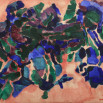杉全 直 SUGIMATA Tadashi 1914–1994
- 眼 1960年 ミクストメディア・キャンバス 65.2x90.9cm
Eye 1960 mixed media on canvas 65.2x90.9cm - 或る地点での記録 1957年 油彩・キャンバス 60x72cm
Record at a certain point 1957 oil on canvas 60x72cm
出展歴:「杉全直個展」1959年、大阪フォルム画廊
Exhibition: 'Tadashi Sugimata solo exhibition' 1959, Osaka Formes Art Gallery, Osaka - 眼 No.7 1960年 油彩・キャンバス 72.7x90.9cm 販売済み
Eye No.7 1960 oil on canvas 72.7x90.9cm sold
東京都に生まれ、姫路に育つ。姫路中学在学中、当時同校の美術教師であった飯田勇に油彩の基礎を学ぶ。1934(昭和9)年東京美術学校油画科に入学、在学中から二科展に出品し、卒業後の1939(昭和14)年第9回独立展で協会賞を受賞。この年、美術文化協会の創立に参加、シュールレアリスム風の作品を同展に発表したが、1953(昭和28)年に退会。日本国際美術展や現代日本美術展に出品するとともに精力的に個展を開催。1955(昭和30)年頃より抽象に転じ、1959(昭和34)年第5回日本国際美術展で鎌倉近代美術館賞を、1961(昭和36)年の第6回展ではブリヂストン美術館賞を受賞。1961(昭和36)年のサンパウロ・ビエンナーレ展をはじめ、海外展にも出品を重ねる。多摩美術大学教授、東京芸術大学教授を歴任。1999(平成11)年姫路市立美術館で「杉全直展」開催。
<西宮市大谷記念美術館 収蔵品データベースより引用>
Born in Tokyo in 1914. graduated from the Tokyo School of Fine Arts in 1938. His early artistic style was influenced by Surrealism. In 1939 he was one of the founding members of Bijutsu Bunka Kyokai [Art and Culture Association], an association of anti-war surrealist painters and poets. The association was suppressed during the war, woth some of its members imprisoned. Sugimata left the group in 1953 and from then on worked independently and focused on showing his work in solo exhibitions, Japanese contemporary art exhibitions or international exhibitions such as the Venice and San Paulo Biennales.
In the mid-1950's, his painting style developed to become more abstract, possibly absorbing some influences of Art informel which had spread rapidly with the help of French art-critic Michel Tapié. From around 1960, a hexagonal shape started to appear in his works and this became his signature subject, producing paintings but also collages and sculptures. Sugimata taught oil painting in Tokyo University of Arts from 1977 to 1981.








